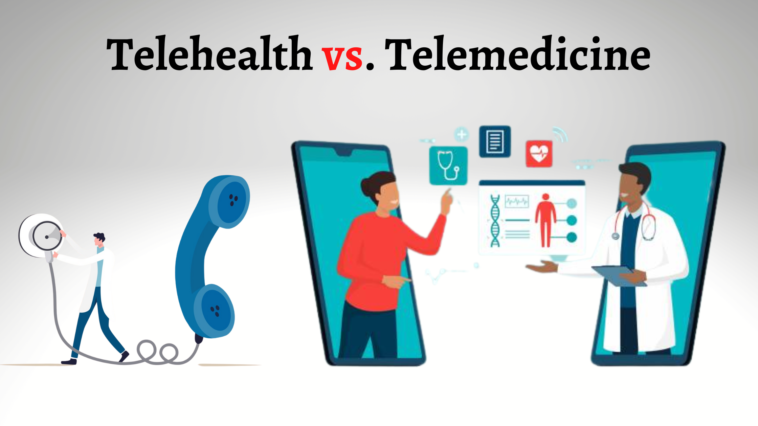Telehealth and Telemedicine both are used a lot, but they are not the same. Compared to telemedicine, telehealth platforms cover a much wider range of topics. In addition to remote medical services, telehealth can include remote non-medical services like medical training, virtual clinical meetings, health checkups with apps, etc. Telemedicine, on the other hand, is only used for medical services far away.
Most of us think of going to the doctor’s office or the emergency room when we think about health care. Patients and their caregivers are expected to leave their homes often while stuck in traffic or rushing from work) to meet their doctor at a healthcare facility, whether the appointment is for a routine checkup, lab tests, an outpatient procedure, or a major surgery. But the way things are is changing. Because of information and communication technology improvements, doctors and other “health and care” providers can now offer more complete, interactive, and remote services to consumers, patients, and caregivers.
A Brief History of How Telehealth and Telemedicine Came to Be
According to a study by Mordor Intelligence, the global IT healthcare app development cost is expected to reach $20 billion by 2020. So, the question is how and when technology started to be used in medicine. According to the National Center for Biotechnology Information, there is evidence in the published literature that telehealth may be traced back to the 18th century. There are two examples of early use of telehealth that stand out:
As the article in the Lancet from 1879 says, there was a discussion about how the telephone could be used to cut down on unnecessary office visits. In a magazine, a doctor was shown using a radio to diagnose a patient. The magazine also talked about the possibility of using a device that would let a video exam of a patient be done from a distance.
According to the National Center for Biotechnology Information, the first organized telemedicine programs in the United States started in the late 1950s. The roots of Telemedicine can be traced back to Europe, where a Dutch doctor named Willem Einthoven sent electrocardiograms over long distances as early as 1905. But you can find the first wave of telemedicine programs in Europe in Europe.
Telehealth
“Telehealth” is an all-encompassing term used to discuss various health-related topics, such as healthcare education, healthcare information services, and healthcare services. The word “telehealth” covers a much wider range of uses than the terms “telecare” and “telemedicine” do on their own. Telehealth includes online visits between patients and doctors, remote monitoring of vital signs like EKGs or blood pressure, and health education programs (Telemedicine). Telehealth technology lets doctors diagnose and evaluate patients from a distance. It also lets doctors monitor changes in a patient’s health at home. This lets the remote diagnosis and evaluation results be used to change the patient’s medications or specific therapy. In addition, it lets doctors write prescriptions for drugs electronically and from a distance.
Telemedicine
This phrase is more limited in what it means than telehealth. It refers to using different telecommunications technology to provide education and health care services. “Telemedicine” refers to information technology and electronic communications to provide therapeutic services to patients at a distance. Telemedicine includes a wide range of practices, such as the digital transmission of medical images, remote medical diagnosis, evaluation, and video consultations with professionals.
The differences between telehealth vs. Telemedicine
|
Telehealth |
Telemedicine |
|
Telehealth encompasses a much broader field than just Telemedicine. Telehealth encompasses a much broader field than simply Telemedicine. Only HCPs play an important part in this situation. Telemedicine is restricted to using digital modes of service provided by medical professionals. This only increases the coverage that physicians may provide. A patient’s health may be improved by the use of Telemedicine, which is the transmission of medical data from one location to another through the use of technology. |
Some examples of telehealth services are as follows:
Beneficiaries use an app on their phone to keep track of their blood pressure and cholesterol levels. With a telemedicine software development company‘s online self-service portal, like a patient portal, patients can see the results of their tests, make appointments, and order prescription drugs. Patients can get online reminders to get their vaccines, refill their prescriptions, or make appointments.
Athenahealth’s robust platform, accessible through the Athena provider login guide, enhances this experience by providing seamless integration with electronic health records, ensuring that patients and providers can efficiently manage and access health information.
Here are some of the ways that telehealth can be helpful:
Health Checks from a Distance: This one-of-a-kind way to keep track of a person’s health makes it easier to set up regular checkups to prevent disease. This links the places where people usually get health care and the patients’ homes and places of work. Using technology that lets the doctor work from home and talks to the patient about the information, the doctor can keep track of a patient’s health improvement and report on it. There aren’t many devices that can collect information like weight, blood pressure, and pulse rate and send it right away to a doctor. The doctor can keep an eye on any strange changes in the patient’s body and find areas of improvement and small problems before they worsen.
This kind of building is helpful because it lets the doctor do so. Thanks to remote technologies, patients can live in a way that keeps them healthy. Mobile Health: This platform lets the user’s health status be tracked continuously through mobile apps. Patients and healthy people alike can use their potential to their advantage. Using mobile devices like cell phones, tablets, and laptops/computers, health lets patients and experts on mobility disorders share educational support materials and health information. People can talk to each other in many different ways, such as through text messages, WhatsApp, the phone, etc. The field of mobile health, also called “mHealth,” is a reliable way to get in touch.
Even though its location limits it, it still provides its services. Live video consultation lets patients talk to their doctors about their treatments and test results through video chats. Also, it works well when doctors from different parts of the world work together to make diagnoses and find the best treatments worldwide. Aside from the costs of building and maintaining the hospital, maintenance costs can be cut, and healthcare providers can offer the best service worldwide.
In rural areas, it’s easier to get around: Virtual healthcare technologies can help patients and doctors a lot when they are used in places where people can access the internet, mobile devices, portable computers, and laptops. Patients in rural areas have easier access to a wider range of medical specialists, and general practitioners see more patients. This condition occurs when a patient cannot move around and has no caretaker. In this case, it’s easy for a patient to get in touch with a doctor specializing in their condition. It may be hard to find the time or the money to get to the doctor, but people with common symptoms need medical help immediately.
Also Read: Top Telemedicine App Development Companies
Here are a few examples of things that can be done with Telemedicine:
When the X-Ray scan report is sent over the internet, a notice is sent to the doctor in charge. Please see a doctor about the strange rash or change in color on your skin, patient.
One of the main reasons Telemedicine is becoming more popular is that it eliminates the need for doctors and patients to meet in person. Because of this, there is a much lower chance of getting a disease spread by pathogens. Middle-of-the-night Telemedicine lets doctors give immediate medical care from far away and lets patients get that care at any time of day or night. Increases doctors’ safety During recent bad situations, like the pandemic and the lockdown, talking to a doctor about a patient’s condition online has worked well.
Help for Sick People Having long-term health problems Telemedicine is a good option for people with chronic conditions who don’t want to go to the hospital in person. This is a very important way for patients to save time and energy. Patients who go to their doctors for help with psychiatric problems get a lot out of the care they get. Personalized medical care and a short time to heal are two of them.
Even though they are different, both groups work toward the same goal: giving people who live in remote areas access to medical care
Telemedicine puts limits on things
When someone needs medical care right away, Telemedicine is not an option. This is only good for treating symptoms, keeping in touch with a patient, and doing health checks. It won’t help if someone has a heart attack, a broken bone, or a stroke.
Concluding Notes
The only difference between Telemedicine and telehealth is that Telemedicine is the delivery of medical care over the internet, while telehealth is the delivery of health care over the internet. On the other hand, telehealth is linked to both medical and non-medical services. Telemedicine is only one of the parts of telehealth that can be taken apart.




Comments
0 comments